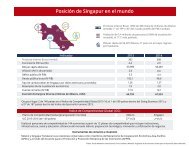basic-guide-to-exporting_Latest_eg_main_086196
basic-guide-to-exporting_Latest_eg_main_086196
basic-guide-to-exporting_Latest_eg_main_086196
Create successful ePaper yourself
Turn your PDF publications into a flip-book with our unique Google optimized e-Paper software.
Certificate of ConformityRequired by some countries, usually for certain kinds of manufactured goods. Exporters arerequired <strong>to</strong> have the product analyzed and tested by an authorized third party.Certificate of OriginRequired by some countries. A signed statement as <strong>to</strong> the originof the export item. Certificates of origin are usually validated bya semiofficial organization, such as a local chamber of commerce.A certificate may be required even if the commercial invoicecontains the same information.NAFTA Certificate of OriginRequired for products traded among the signa<strong>to</strong>ry countriesof the North American Free Trade Agreement (Canada, Mexico,and the United States) if the goods are NAFTA qualified and theimporter is claiming zero-duty preference under NAFTA.Inspection CertificationRequired by some purchasers and countries <strong>to</strong> attest <strong>to</strong> thespecifications of the goods shipped. The inspection is usuallyperformed by a third party, often an independent testingorganization.Specific certificates of originare sometimes required forcountries involved in special tradeagreements, such as the NorthAmerican Free Trade Agreement(NAFTA), which was signed byCanada, Mexico, and the UnitedStates. For example, a NAFTAcertificate of origin validates thata good originated in a NAFTAcountry and is eligible for thepreferential duty rate.Dock Receipt/Warehouse ReceiptUsed <strong>to</strong> transfer accountability when the domestic carrier moves the export item <strong>to</strong> the port ofembarkation and leaves it with the shipping line for export.Destination Control StatementAppears on the commercial invoice and on the air waybill or bill of lading <strong>to</strong> notify the carrier andall foreign parties that the item can be exported only <strong>to</strong> certain destinations.Shipper’s Export DeclarationUsed <strong>to</strong> control exports and is a source document for official U.S. export statistics. Shipper’sExport Declarations (SEDs) must be filed electronically by you, your freight forwarder, or anotherqualified third party whom you designate. SEDs are required for shipments when the value of thecommodities, classified under any single Schedule B number (the four-digit U.S. extension <strong>to</strong> thesix-digit code under the Harmonized Tariff System), exceeds $2,500. SEDs must be prepared andsubmitted for all shipments, r<strong>eg</strong>ardless of value, that require an export license or are destined forcountries restricted by the Export Administration R<strong>eg</strong>ulations (see Chapter 10). The U.S. CensusBureau’s Foreign Trade Division is the controlling agency for this document, and AESDirect(aesdirect.census.gov) allows exporters <strong>to</strong> file SEDs electronically for free. Often, the SED isprepared as a by-product of another document: the shipper’s letter of instructions.Chapter 12: Shipping Your Product139





